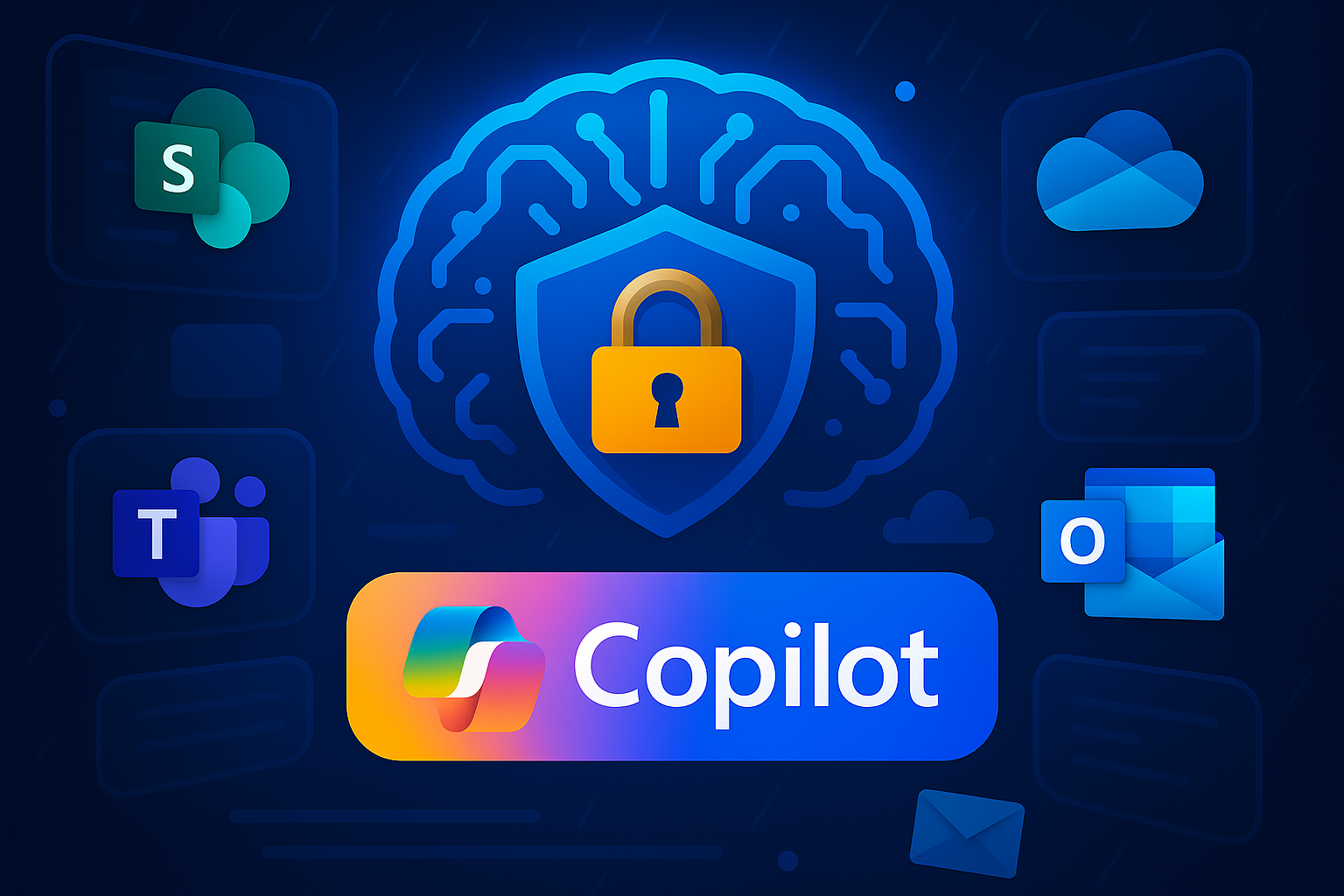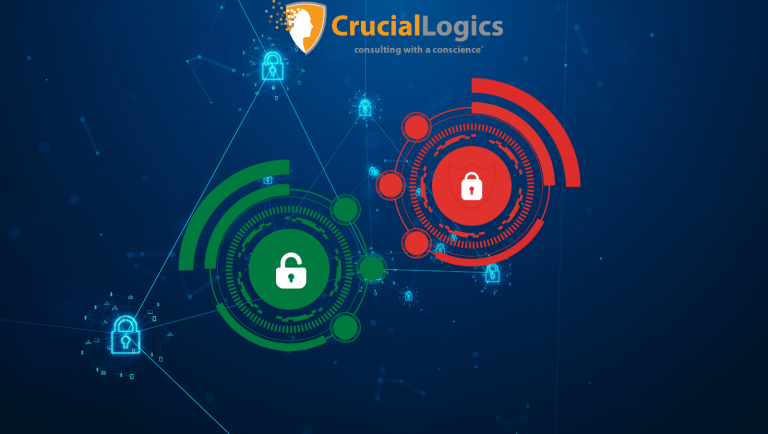Microsoft Copilot governance is a critical initiative that helps secure your Microsoft 365 environment against both internal and external data threats.
Copilot is changing the way we work inside Microsoft 365, pulling insights from emails, chats, files, and meetings in seconds. However, that same capability also carries a significant amount of risk. A single question, such as “What’s the status of the client acquisition?” will likely elicit a response that includes project plans, board discussions, and financial forecasts, without the user even realizing it.
According to a Salesforce survey, just about 11% of CIOs have fully implemented AI, citing infrastructure and security challenges. 84% agree that AI is revolutionary, but 67% are taking a more cautious approach compared to other technologies.
In this blog, we’ll walk through how Copilot accesses your organizational data, what can go wrong without proper controls, and how to build a governance model that protects your business without restricting Copilot.
How Copilot Accesses Your Data
Copilot operates across multiple apps within your Microsoft 365 environment. When a user submits a prompt, Copilot utilizes the ‘grounding’ technique to retrieve data from various sources. Here’s how it works:
- SharePoint: Copilot fetches files the user technically has access to, even if they’ve never opened them. That can include archived strategy decks, planning documents, or financial forecasts.
- Teams: Conversations across different channels, group chats, and archived threads become a repository. A simple query could pull in informal side chats that were never intended to be part of a formal report.
- Outlook: Calendar invites, attachments, and patterns in email exchanges get interpreted to offer context. Copilot may surface insights based on relationships or decisions inferred from past correspondence.
- OneDrive: Draft documents and work-in-progress files can be included in Copilot’s synthesis when users overlook file sensitivity labels.
The risk isn’t just about what Copilot can access; it’s how it connects the dots. The synthesis of unrelated files, private conversations, and outdated documents can be combined to create a response that unintentionally exposes sensitive data.
Key Risks of Using Microsoft Copilot Without Governance
Microsoft Copilot promises to enhance productivity across multiple departments; however, without proper guardrails, it may introduce gaps in your security footprint.
Data Leakage Threat
If an employee asks Copilot for a summary of “our top investment opportunities,” the AI might pull in data from multiple locations, such as internal forecasts, private client portfolios, and draft strategy decks that haven’t been reviewed or approved.
Individually, those documents seem harmless. But when synthesized into a single AI-generated summary, they could unintentionally reveal non-public financial plans or confidential client information. If that summary is then shared externally with a vendor or partner, the issue may escalate into a compliance breach, even though the user never directly accessed or intended to leak sensitive content.
This is how accidental data leakage occurs. While the user isn’t acting maliciously, the risk comes from Copilot’s ability to infer, connect, and surface information in ways that traditional access controls were never designed to anticipate.
Shadow Prompts
Employees could be the biggest risk in your line of cybersecurity defense. Shadow prompts, often used as the pathway to this insider risk, are queries where the sensitivity lies in the question itself. An employee could use sensitive prompts like “what’s our fallback if the Johnson acquisition falls through?” or “which clients are we worried about losing?”
Even before Copilot responds, the question may reveal a confidential strategy. Employees often use Copilot as an informal knowledge base, asking questions that may unintentionally expose leadership concerns.
Access Escalation via AI
If an administrative assistant at a healthcare institution asks Copilot, “What appointments have been rescheduled for next week, and why?”, the AI may access scheduling logs, email threads, and meeting notes tied to patient records.
Because the assistant has technical access to scheduling tools, Copilot could unintentionally surface embedded notes containing personal health information (PHI), such as diagnoses or treatment updates, that are contained within calendar comments or internal communications.
Although the assistant never directly opened a patient file, the synthesized output violates HIPAA regulations. The escalation happens not through intentional overreach, but through AI stitching together fragments of information from multiple sources that the user has partial access to.
This illustrates a core governance challenge: Copilot doesn’t just retrieve data—it contextualizes it, sometimes in ways that exceed the user’s role or original intent.
Compliance Gaps
Copilot introduces a layer of compliance risk that’s easy to overlook. In regulated industries such as healthcare and financial services, sensitive data can appear in AI-generated summaries or suggestions, even if users never accessed the original files directly.
This makes auditability more complicated. It’s not just about logging who opened what anymore. You also need to account for who viewed AI-synthesized content and what data may have been exposed in the process. This means taking a closer look at how Copilot interacts with protected health information in shared spaces, especially when content is pulled together on the fly without users realizing what is being surfaced.
What Microsoft Copilot Governance Includes
Microsoft Copilot governance goes far beyond access control. It’s about defining how Copilot interacts with enterprise data, how data is recombined, and ensuring accountability in every step of the AI workflow.
At the core is data that controls what Copilot can access and how it presents that information to users. Such controls are crucial in preventing unintended data exposure, especially when Copilot pulls content from multiple sources across Microsoft 365.
Prompt monitoring is another vital capability. Rather than reacting solely to Copilot’s outputs, organizations should evaluate the intent of the questions users ask. This proactive approach helps to flag risks that might otherwise go unnoticed until it’s too late.
Access management also plays a key role. With role-based access controls, organizations can ensure that only authorized users can perform specific tasks within Copilot. This prevents misuse by limiting access to sensitive information.
How to Build a Copilot Governance Framework
Phase 1: Discover and Map Sensitive Data
Effective Copilot governance begins with understanding what sensitive data exists in your environment and how it’s currently protected. This goes far beyond traditional file inventories to include understanding data relationships, access patterns, and potential synthesis risks.
Start by mapping your most sensitive data across all Microsoft 365 platforms. This includes prominent locations such as SharePoint document libraries and OneDrive folders as well as less obvious places like Teams chat histories, email attachments, and calendar entries, that may contain sensitive information.
Pay particular attention to archived content that users might have forgotten, but Copilot can still access. Old project files, discontinued initiatives, and historical communications often contain sensitive information that could be problematic if surfaced in current contexts.
Phase 2: Define Specific Use Cases
Generic policies are not effective for AI governance because the same action may be appropriate in one context but dangerous in another. Instead, develop specific use cases that clearly define appropriate and inappropriate AI interactions.
For customer service teams, Copilot may be suitable for drafting email responses and summarizing customer interactions; however, it is not ideal for accessing detailed financial records or internal strategic discussions regarding client relationships. For executive assistants, access to AI-generated calendar information and meeting notes may be essential, but access to confidential HR discussions or financial forecasts should be restricted.
Document not just what users can do, but how they should think about AI interactions. Provide clear guidance on when to use Copilot for routine tasks versus when to seek human expertise for sensitive matters.
Phase 3: Apply Adaptive Access Controls
Traditional access controls assume static permissions, but AI governance requires dynamic controls that adapt based on context, behavior, and risk levels. Microsoft Entra provides the foundation for these dynamic controls through conditional access policies that consider multiple factors simultaneously.
Implement device-based restrictions that limit Copilot access from unmanaged devices or high-risk locations. Use behavioral analytics to apply additional scrutiny when users exhibit unusual AI usage patterns or attempt to access information outside their usual scope.
Consider implementing time-based restrictions for particularly sensitive functions. For example, access to financial data through Copilot may be restricted outside of regular business hours or during sensitive periods, such as earnings announcements or acquisition negotiations.
Phase 4: Monitor and Evaluate
AI governance isn’t a set-it-and-forget-it initiative. As AI capabilities evolve and usage patterns change, your governance framework must adapt accordingly. Establish regular review cycles that analyze usage patterns, policy effectiveness, and emerging risks.
Monitor not just policy violations, but also near-misses and edge cases that might indicate gaps in your governance framework. Pay attention to user feedback and questions about AI boundaries, as these often reveal areas where policies need clarification or adjustment.
How Microsoft Purview Supports Copilot Governance
Microsoft Purview plays a foundational role in enabling effective Copilot governance. As Copilot interacts with sensitive data across Microsoft 365, Purview provides the visibility, classification, and control mechanisms necessary to reduce risk, enforce policy, and maintain compliance.
Advanced Discovery and Adaptive Protection
One of the biggest challenges in Copilot Governance is surfacing sensitive data that lacks proper labels or classification. Purview addresses this through automated discovery. It continuously scans Microsoft 365 environments for sensitive or unclassified information that may be at risk of exposure through Copilot prompts.
Once data is identified, dynamic classification policies can be applied. These go beyond static labels by adapting protection levels based on how the content is being accessed or used.
For example, a document might be treated as “Internal Use” when opened by a marketing analyst, but flagged as “Confidential” if referenced during an AI-assisted legal inquiry. This level of contextual sensitivity ensures that data governance scales alongside the dynamic nature of AI.
Insider Risk Detection and Behavioral Monitoring
Through built-in insider risk detection capabilities, Copilot analyzes usage patterns and highlights anomalies that may signal misuse or negligence.
For example, if a user suddenly begins querying Copilot for unusually high volumes of sensitive information, especially outside of their normal responsibilities, Purview can trigger alerts. This enables administrators to identify and address any potential risks.
AI-Specific Audit Trails for Compliance
Governance is not complete without traceability. Purview provides comprehensive audit logs that extend beyond AI-specific interactions. These logs track how Copilot retrieved, combined, and presented that data in response to prompts.
This level of insight is critical for:
- Internal security reviews.
- Legal or regulatory audits.
- Incident response investigations.
Common Copilot Governance Mistakes to Avoid
Even with tools like Purview in place, missteps in implementation can compromise your governance framework.
Overreliance on Traditional Permissions
Copilot operates differently from human users. It doesn’t respect folder-level boundaries the same way people do. If a user has partial access across multiple repositories, Copilot can inadvertently “connect the dots,” synthesizing insights from data that should never be combined.
Ignoring Prompt-Level Risk
Governance is about intent. Questions like “What’s the story behind recent executive departures?” or “What were the financial impacts of Project Orion?” may seem straightforward. Still, they reveal more through aggregation than direct access ever could.
If governance focuses solely on content, rather than the nature of the queries being submitted, critical gaps remain open.
Over-Restricting Copilot Functionality
A common precautionary practice adopted by most organizations is disabling Copilot. However, when basic tasks like email summarization or internal research are blocked, users often turn to unregulated third-party AI tools.
This creates a shadow AI ecosystem with no oversight, increasing your organization’s exposure far beyond what Copilot would have caused.
Excluding Legal and Compliance Stakeholders
Copilot may create content that may fail to meet legal guidelines, data residency requirements, or industry-specific regulations. If legal and compliance teams are not consulted early in the governance planning process, the risk of regulatory non-compliance increases significantly.
Failing to Prepare Users Through Change Management
Even the most robust controls will fail if users don’t understand them. Most governance failures stem not from technical flaws, but from misaligned user behavior. Employees need to know:
- How to use Copilot responsibly.
- Why specific actions are restricted.
- What to do when encountering a governance policy in action.
Without this level of education, governance is likely to be misunderstood or circumvented.
Conclusion
Copilot governance isn’t just about restrictions–it involves responsible management that includes your legal, compliance and employees to define what responsible Copilot use should look like across the organization.
Start by involving stakeholders to map out your sensitive data, apply dynamic access controls and monitor and evaluate.
For a detailed Coplot governance assessment that pinpoints gaps, identifies gray areas and provides an actionable strategy, speak with us today.






